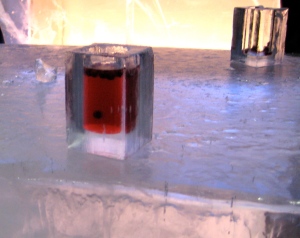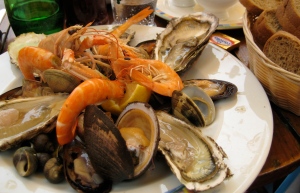 If you cut your potatoes with a knife in Germany, you will insult your hostess. Go ahead and slurp your noodles in Japan – it shows you are enjoying your lunch. In India, you are expected to eat your rice and curry by hand, but using your left hand will disgust your host.
If you cut your potatoes with a knife in Germany, you will insult your hostess. Go ahead and slurp your noodles in Japan – it shows you are enjoying your lunch. In India, you are expected to eat your rice and curry by hand, but using your left hand will disgust your host.
While many Americans make an effort to be polite overseas, we may be shocked to learn that what we consider proper table manners looks rude in other lands and vice versa. Awareness of simple rules and taboos can save us from embarrassment abroad, but deeper examination of varying etiquettes around the globe can provide insight into the cultural differences that define us.
Vinita Chopra Jacinto grew up in northern India and is now an instructor at the California Culinary Academy in San Francisco. She explains that Indians eat with their hands because they believe that food is more than “just protein, carbs and fat … it nourishes the mind, intellect and spirit. Food has to be sensual and mindful. Eating with your hands gives you a connection with the food. It’s the least violent way to eat.”
In the Indian, Pakistani, Arab and African cultures that shun silverware, eating with your hands doesn’t mean that anything goes. Before the meal, the hands must be washed, wiped or even rubbed with sand, as desert Arabs do. But the foremost rule is that only the right hand may be employed for eating.
“The left hand is never used for that,” Jacinto says, “It is considered unclean.” In principle, at least, this is because the left hand is saved for elimination.
Another taboo Jacinto describes is jutha or double dipping your bread into a communal dish of food, “It is never done,” she cautions. Also, in Indian culture, you are expected to clean your plate. “Grain is so important in India, that not one grain should be left.” This brings up an interesting contradiction: in China, Japan and India, finishing every last grain of rice you are served is proof that you enjoyed the meal. While in Cambodia, Jordan, Egypt and the Philippines, it is more polite to leave a little food on your plate. An empty plate could insult your hosts, implying that they did not serve you enough.
In fact, every culture has specific ways of showing appreciation of the meal. In Saudi Arabia, diners burp after eating to compliment the cook. In Hong Kong and Japan, loudly slurping your noodles demonstrates your enjoyment of the food; literally, that it is so delicious you cannot even wait until it cools off.
The use of chopsticks in Japan carries another set of rules. Kim Mosby, an American who has lived in Japan for the past six years, discovered that if you want something that is out of reach and another person offers to pass it to you, give them your plate. Do not take the item with your own chopsticks. Two people passing the same morsel of food from chopstick to chopstick is considered a huge faux pas because, Mosby explains, “In a traditional Japanese funeral, the relatives of the deceased use chopsticks to pass the cremated remains to each other and finally place them into the urn. The passing of an object from chopstick to chopstick has come to symbolize death of a loved one.”
Members of cultures that eat with their hands or chopsticks have to follow specific rules of etiquette. But since you only have two hands or one set of chopsticks, the chances of using the wrong utensil are relatively small compared to the vast potential for embarrassment given the dozen different implements wielded by Americans at a formal dinner. We have no qualms about laying out knives for fish, fruit, salad and steak. In Asian countries, however, knives still carry an association with violence and are rarely set on the table. Even in Europe, the manners connected with knives differ greatly from our own.
Rudi Raab grew up in Germany, and moved to California 35 years ago, after marrying an American woman when he was 20. He still remembers an embarrassing moment at his first restaurant meal in California with his new mother-in-law. Everyone ordered hamburgers. As is the custom in Germany, when the food arrived, Raab picked up his knife and fork and began cutting the big bun and juicy burger into bite-sized pieces.
His mother-in-law was amused and Rudi explained that in Germany, “You never take any food in your hands. It’s always eaten with a knife and fork.” On the flip side, Raab advises travelers to Germany, “Never use your knife to cut the boiled potatoes that are commonly served. It’s insulting to the hostess. Like saying that they are not tender enough to eat. Use the side of your fork, instead.”
On our travels, it is not only new foods, but also new ways of eating, that can give us a fresh perspective to take home. In Japan, you need to remember to turn your chopsticks around and use the wider ends when taking something from a serving dish for hygiene. In France, you might need some practice to master the French art of folding your lettuce leaves into a little packet over your fork (they believe that cutting them bruises the delicate greens). In India, you may have to actually sit on your left hand to make sure it doesn’t join you while dining.
Eating a meal with others’ utensils may deliver more appreciation of cultural differences than walking a mile in their shoes. The story goes that after sensuously dining with his hands in India, the former Shah of Iran was so impressed that he likened eating with a fork and spoon to making love through an interpreter.














